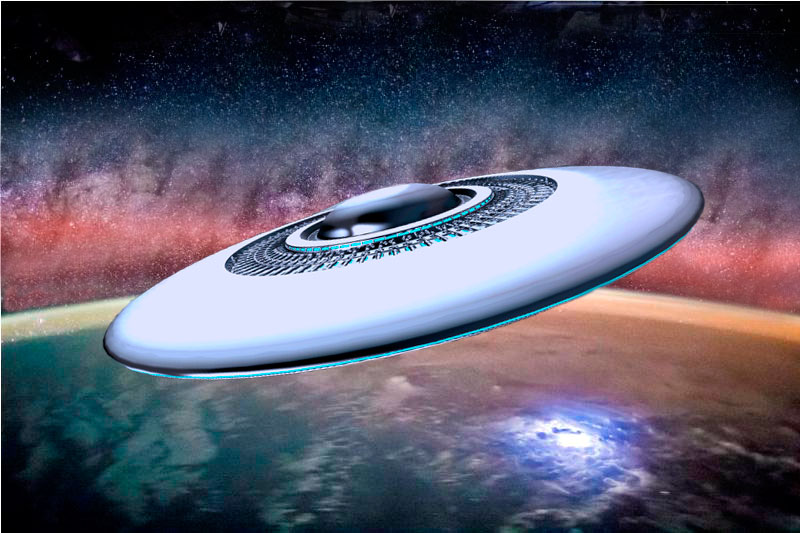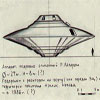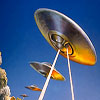Overcoming Gravity To Achieve Space Travel
Perhaps the greatest obstacle to man’s achievement of his dream of space travel has been a factor which has been given the name of Gravity. Its ‘discover’ is usually credited, in elementary school test books, to a seventeenth century mathematician and physicist, Sir Isaac Newton. Actually, of course, every man ‘discovers’ gravity soon after birth; and the stone age man who first rolled a boulder down upon the head of the cave bear who was attempting to scramble up the cliff after him, was making a practical application of this force. It was, however, Sir Isaac Newton who first made a complete mathematical analysis of the subject. His conclusions were compatible with subsequent observation and test, and were virtually unchallenged until the dawn of the era of relativity.
In brief, his conclusions were that gravity is a quality which is inherent in all matter, and that it manifests itself as a mutual attraction between all bodies of matter. The value of this attraction between any two given bodies was said to be directly proportionate to the product of their mass, and inversely proportionate to the square of the distance between them. The attraction between the earth and an object near its surface is known as the weight of the object. The difficulty with the statement that the force varies inversely as the square of the distance lies in the implication that if the distance becomes zero, the force should become infinite. Thus it would at first seem that a man standing or lying upon the surface of the earth would be one of two bodies between whom the distance was zero, therefore, the weight of the man should be infinitely great. The reply to this assumption is that the Force acts as though it originated at the center of the mass, called the ‘center of gravity’, and that the man on the surface of the earth is still some four thousand miles from its center of gravity. This explanation, however, creates a new problem in that, if we accept it literally, we must assume that if there were a well or shaft extending to the center of the earth, and if a man descended this shaft, his weight would increase as he approached the center of gravity, becoming infinite as he reached it. Actually, of course, his weight would decrease, becoming zero when his center of gravity coincided with that of the earth. So we are forced to the further explanation that gravity is inherent, not in ‘bodies,’ but in particles of matter, and since a man at the center of the earth would have an equal number of particles attracting him from every direction, the resultant of the forces would be zero.
If we assume the gravity to reside independently within each atom, our problem is solved as far as the man and the earth are concerned, but if we look within the atom itself in the attempt to find the point where the distance becomes zero, and the force infinite, we find that the same problem again confronts us. We have not solved it, we have only changed our scale of observation. There is conclusive evidence that the attraction, called the binding energy, which exists between the Newtonian particles, (the protons and the neutrons) is intense almost beyond our ability to describe. This force, however, does not increase uniformly with increasing mass, but at certain points not only reaches zero but actually becomes negative.
We can demonstrate this fact by adding a single unit of Newtonian mass, a neutron, to the nucleus of an atom of Uranium 235. When this is done, we find that the gravitational force within the nucleus, instead of increasing actually becomes negative, that is, the attraction between its parts becomes a repulsion, and the parts begin to separate with considerable pressure. During the expansion, however, several new centers of gravity are formed, which, because of the smaller amount of mass involved in each, are strongly positive. The result is that two or more simpler atoms are formed, plus a few neutrons which have acquired too great a velocity to be captured by this regrouping process.
This phenomenon, if carefully examined and considered, will furnish several strong clues to the nature of gravity itself, but let us for the moment, content ourselves with the observation that it demonstrates; that a gravitational field can, under certain conditions, become negative.
Because of the manner in which our gravitational laws have been expressed, it has commonly been assumed that a gravitational force can manifest itself only as an attraction between two bodies of matter. This is not, however, a necessity of thought, since there is no logical reason why it should necessarily be true: In fact if it were true, it would set gravitational fields apart as the only force fields with which we are familiar which could not produce a repulsion, as well as an attraction between bodies of matter. The reason for the assumption of a universal attraction is simply that all of our early and limited observations seemed to indicate that this was true. However, as we have already mentioned, any number of observations, if made on a sufficiently limited scale, will tend to indicate that the earth is flat, rather than spherical.
For many years a school of thought existed which recognized that gravitational fields, like all other fields, must possess a dual polarity. They called these poles, gravity and levity. They assumed that some objects and materials normally possessed the quality of gravity, while others normally possessed the quality of levity. An object possessing levity would be repelled by all objects possessing gravity. The theory eventually became discredited, and was almost universally discarded, not because it was ever disproved, but because so many attempts had been made to assign this quality of levity to objects and materials which did not actually possess it. For instance it was, for a time, assumed that gases such as hydrogen and helium possessed levity because when they were contained in a light bag or envelope, they were observed to rise against the gravitational field. It was soon demonstrated, however, that its rise was caused, not by any quality of levity, but simply because of the fact that its specific gravity was less than that of the air which it displaced. After a number of unsuccessful attempts to assign the quality of levity to specific materials or objects, the theory fell into disrepute to the extent that the very word levity has become synonymous with humorous nonsense. Nevertheless, the philosophers who developed the theory were perfectly correct in their primary postulate. They erred only in failing to realize that gravity and levity are not properties of specific materials but are conditions under which all matter may come.
We have now observed negative gravitation in the microcosm (the interior of the atom), we also observe it in the macrocosm, (between the galaxies).
Many technical articles have been written in recent years, concerning “Our Expanding Universe,” yet where, in any of them, can we find any logical explanation or reason why it should expand at all. Under the theory of universal attraction, all of the matter in the universe should be rapidly coalescing into one gigantic lump. Instead, we find that every one of the large groups of stars which we call ‘galaxies,’ is rapidly retreating from every other group, at velocities which increase with their distance from the observer. Velocities of recession exceeding 25,000 miles per second have been calculated.
A number of interesting but hardly convincing theories have been advanced in the attempt to reconcile the observed state of the universe with the existing concept of universal attraction. Some of our cosmic theorists have proposed that at one time all of the matter in the universe was contained in a single tremendous star, or ‘atom.’ For some reason, which is not given, this atom exploded, hurling outward the matter which has become the star clusters, and imparting to them the motion which we now observe, several billions of years later. We will only point out here that such a theory will not stand up when examined under our linear concept of physical law. In the first place, such an inconceivably huge mass of matter, even at the very great temperature which was assumed for it, would, under Newtonian laws, produce a gravitational field so intense that no velocity less than that of light itself would be an ‘escape’ velocity. In fact it has been calculated that even the light emitted by this huge sun would not escape completely, but would circle in a comparatively small orbit about it. Through the concept of the curvature of physical law however we see that the addition of mass to an existing body does not, necessarily, increase the force of attraction between its parts, but may, under certain conditions, cause the field to become negative, and the attraction to become a repulsion. We can explain the observed actions of the present universe by postulating that an attraction exists between the individual bodies within a galaxy, because their total mass and distance is such that they are within the positive portion of the gravitational curve with respect to each other. In the vast spaces between the galaxies however, the curve dips below the zero line, with the result that a repulsion exists between the galaxies themselves. This also explains why matter, although rather evenly distributed throughout the known universe, is not distributed uniformly, but is found in quire similar concentrations at comparatively regular distances.
At this point we hear someone say, “These explanations may be very interesting to the astronomer or to the theoretical physicist, but how can they help us in achieving space travel?” The answer is, of course, that we must have some understanding of the physical laws before we can make the proper use of them in attaining our own personal ambitions.
In his dreams of space travel, man has generally considered only three possibilities of escaping from the earth. First, gravity must be destroyed. That is, the operation of the gravitational field must cease between the space craft and the earth, so that it will not hinder the departure of the craft. While a number of highly imaginative stories have been written along this line of thought, no theory has ever been evolved, or test conducted which could give us any hope that such a condition can be achieved.
Despairing of the first possibility, we pass on to the second. Gravity must be shielded. Some type of screening material must be interposed between the craft and the earth to cut off or absorb the gravitational field so that while it still exists, it will no longer act upon the craft. Here again we have found imagination raising our hopes, and reality disappointing, for no material has been discovered which shows any promise of fulfilling such a function. With our hopes considerably subdued, we pass on to the third possibility. Gravity must be overcome. We must apply a greater force, so that we can rise against the pull of gravity, even though we much pay an exorbitant tribute of energy for each foot of progress. In this last plan, we have a slight degree of initial success. Rocket motors have fought and struggled their way upward against the implacable, if impersonal, pull of the earth’s gravitational field, for distances of up to two hundred and fifty miles. While this is a very small step toward complete escape from the earth, the fact that any progress at all could be achieved has so stimulated the age old ambition, that science is now devoting a large portion of its total effort to this ‘last hope of escape’.
When man attempts to attain his ends by pitting one natural law against another, he usually finds that it is a wasteful and laborious process. While it is true that it is perfectly possible to propel a rowboat by throwing rocks from the stern, it is not a method which an intelligent man would choose if he were aware of other possibilities. In the first place, the thrown rock must accelerate, not only the boat, but all of the rocks which remain to be thrown. If a long journey were planned, the greatest problem would be to find enough room in the boat to store the required number of rocks. Since the thrust produced is equal to the mass of the rock multiplied by the velocity of its ejection, it is obvious that there are three limiting factors. First, there is the total mass of the available rock, which is limited by the size of the boat which contains them. Second, there is the total amount of energy available. (This is a factor only because we have so little understanding of the true nature of energy.) The third, and at the present time the most serious factor, is the limited mechanical strength of the throwing arm.
In a rocket motor, the ‘rocks’ are represented by a gas produced by combining or ‘burning’ the fuels within the combustion chamber. The gas, at a high temperature and pressure, is expelled through an opening or ‘venturi’ in the stern. Since the amount of fuel is limited by the size of the rocket, the only means of increasing the total thrust is to increase the velocity of ejection, but this can only be accomplished by increasing the temperature and pressure of the gas within the combustion chamber. Regardless of the amount of energy which is available, the amount of thrust which can be produced is limited by the ability of the chamber to withstand the temperatures and pressures involved. Since these limits are reached (and often exceeded) by ordinary chemical energies, it is clear that the vastly greater energies available in nuclear reactions are, at the present time at least, of academic interest only to the rocket engineer. In the case of craft which remained in our atmosphere, of course, more ‘rocks’ could be taken aboard while in flight by scooping up the atmosphere through which the ship was traveling, and allowing the surplus energy to act upon it. In space flight, however, this is not possible, and it is hardly likely that the efficiency of the rocket motor can be increased sufficiently in the near future to permit of practical or economical space travel.
Actually, the rocket has been obsolete for centuries. There has not been a single basic advance in the rocket concept since the year 1214 A.D., when the invading hordes of Genghis Khan were met by the military ordnance rockets of the Chinese defenders in their walled cities, more than seven hundred years ago. True, we have produced stronger combustion chambers. We have improved slightly the shape of the venturi, and we have developed fuels with considerably higher specific impulse, but we have done nothing to advance the basic concept. We are still propelling our boat by throwing rocks over the stern.
Men now living will stand upon the surface of Mars and Venus, but they will not go there in a rocket. There are better and simpler ways.
It is time to reexamine our position to see if there is not something that we have overlooked. Have we forgotten the old saying, “If you can’t lick ’em join ’em”?
We have tried for centuries to ‘lick’ the force of gravity. We have tried to destroy it, and failed. We have searched for some method of shielding ourselves from its effect. We have not discovered it. We have attempted to overcome it by opposing it with superior force, and found it a wasteful and cumbersome process. Isn’t it about time we gave up the idea of fighting the force of gravity, and began to consider the possibilities of making use of it?
We have learned that gravity, like all natural factors has a negative, as well as a positive value. If after building our space craft, we could arrange conditions so that the ship was in the negative portion of the gravitational curve, it would fall away from the earth as easily and as naturally as a stone dropped from a tower falls toward the earth.
Of course, we hear at once the objection that, while negative gravitational fields have been shown to exist, they have been found only within the atom, and at inter-galactic distances. How can we place a space ship within the negative portion of the curve, with respect to the earth ? The answer to this question lies in the fact that, as we have already learned, the natural laws are not absolute, but relative. That is, the size and shape of the curve of one law is dependent upon the value and position of the others. We have seen that the nucleus of the atom of uranium 235 dips below the zero line with the addition of only one mass unit, making, a total of 236, yet the nucleus of the atom of uranium 238, although close to the zero line is still on the positive side of the curve because of the fact that the shape of the gravitational curve is modified not only by the mass present but also by the number and position of the electrical charges. Lest someone charge us with ignorance by pointing out that there are the same number of electrons (92) in each of these atoms, we will make haste to state that we refer not only to the charges in the outer shell of the atom but to those within as well, and especially to the fact, not always realized, that the neutron possesses both a positive and a negative charge, although when united within the neutron they are not discernable as charges, but exist as energy (a part of the binding energy which produces the gravitational field).
When we acquire a better understanding of the natural we will be able to produce any shape of curve we desire, with the earth as one reference point and the spacecraft as the other.
Suppose you were to hand a bar magnet and a similar bar of soft iron to a man who was intelligent, but uneducated, with the request that he examine and test the two objects in order to determine their properties. One of the properties which the researcher would be certain to list would be the ‘inherent’ property of mutual attraction between the two objects. He would observe that when either end of one bar approached either end of the other bar, a condition of attraction was observed. He would probably conclude that the attraction was an inherent duality of these objects, and that it would continue to persist regardless of anything which could be done.
We know, of course, that if a length of insulated wire were wound around the soft iron bar, and a flow of electrons were induced in the winding, the two bars could be made to exhibit a repulsion as readily as an attraction. Note that in this case we have not destroyed the field of the permanent magnet, we have not shielded the field, nor have we overcome it. We have simply produced a field which is in opposition to it, or to state the case more concisely, we have polarized the field, by placing one end of the soft iron bar within the negative portion of the magnetic curve with respect to each end of the permanent magnet which is already so polarized.
The same possibility exists with respect to gravitational fields except that the results are not obtained in quite the same way. It is not too difficult, however, to work out means of polarizing a gravitational field, once we discard the old assumption that it is impossible.
SUMMARY
To sum up as concisely as possible, the conclusion reached in our discussion of the factor of nature which we call gravity, we will propose the following corrections and additions to the gravitational theory as it is now commonly taught.
- The law of gravity is not a linear law but follows a curve common to all factors of nature.
- The gravitational field does not diminish precisely as the square of the distance as Newton believed, but because of the curvature of natural law, it diminishes normally at a slightly greater rate so that it reaches zero value, not at infinity as is usually supposed, but at a finite distance or degree of separation. Beyond this distance or degree of separation the force becomes negative.
- We can define a gravitational field as negative when the application of the factor called time tends to increase the degree of separation between any two reference points in the factor called matter.
- The value of the gravitational field at any given point is controlled by the values of the other factors of nature at that point.
- The electric charges within the atom are a factor which modulates the shape of the gravitational curve of the nucleus.
- Gravity is not the enemy of space travel. It is a friend, but there must be true understanding before the friendship can bear fruit.
- It is perfectly possible to produce a negative gravitational field between the earth and a given object on or near its surface by the proper application of moving electric charges. Such a field would be effective only with respect to the given object. All other matter in the vicinity would remain within the positive portion of the curve.
Excerpt from Step To The Stars
Posted in Science For The New Agewith comments disabled.






